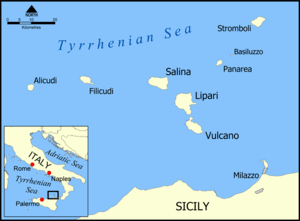Battle of the Lipari Islands
| Battle of the Lipari Islands | |||||||
|---|---|---|---|---|---|---|---|
| Part of the First Punic War | |||||||
 the Lipari islands, also known as the Aeolian Islands | |||||||
| |||||||
| Belligerents | |||||||
| Carthage | Roman Republic | ||||||
| Commanders and leaders | |||||||
|
Boodes Hannibal Gisco | Gnaeus Cornelius Scipio Asina (POW) | ||||||
| Strength | |||||||
| 20 ships | 17 ships | ||||||
| Casualties and losses | |||||||
| None | 17 ships captured | ||||||
The Battle of the Lipari Islands or Lipara in 260 BC was the first encounter between the fleets of Carthage and the Roman Republic during the First Punic War. A Roman squadron of 17 ships commanded by the senior consul for the year Gnaeus Cornelius Scipio was trapped in Lipara harbour by 20 Carthaginian ships under Boodes. The inexperienced Romans made a poor showing, losing all 17 of their ships captured.
Prelude
After some successes with their army in Sicily such as the conquest of Agrigentum, the Romans felt confident enough to build and equip a fleet that would allow them to control the Mediterranean Sea. The Republic ordered, built and drilled the crews of a fleet of about 150 quinqueremes and triremes in a record two months.[1] The patrician Gnaeus Cornelius Scipio (the year's senior consul) was given the command of fleet. He put to sea with the first 17 ships produced. As the first ever Roman warships they spent some time training in home waters before sailing to Messana. There they prepared for the main fleet's arrival and supported the logistics of Roman army at the crossing to Sicily.[2][3]
While Scipio was at the Strait of Messina he received information that the garrison of Lipara was willing to defect to the Roman side. Lipara was the main port of the Lipari Islands and was a constant threat to Roman communications across the Strait. What happened next is usually described as a treacherous act of the Carthaginians, but the sources do not give much detail and are usually pro-Roman. Though the crews were still inexperienced and the newly designed and built ships were still undergoing their sea trials, the consul could not resist the temptation of conquering an important city without a fight and sailed to Lipara. It has been suggested by some ancient sources that the offer to surrender Lipara was a ruse inspired by Carthage to encourage the Romans to commit their ships where they could be ambushed.[4][5]
The battle

The Romans entered the harbour at Lipara. The Carthaginian fleet was commanded by Hannibal Gisco, the general defeated at the Battle of Agrigentum and was based at Panormus, modern-day Palermo, some 100 kilometres (62 mi) from Lipari. When he heard of the Romans' advance to Lipara he despatched 20 ships under Boodes, a Carthaginian aristocrat, to the town. The Carthaginians arrived at night and trapped the Romans in the harbour. Boodes led his ships in an attack on the Romans inside the harbour the next morning. Scipio's men offered little resistance. The inexperienced crews were no match for the well drilled Carthaginians and were rapidly outfought. Some Romans panicked and fled inland and the consul himself was taken prisoner. All of the Roman ships were captured, most with little damage.[6][5][7]
The battle was little more than a skirmish, and is mostly notable as the first naval encounter of the Punic Wars and the first time Roman warships had been engaged in battle.[2][8]
Aftermath
Scipio was later released, probably ransomed. His easy defeat earned him the pejorative cognomen Asina, which means donkey in Latin. This cognomen was all the more insulting because "asina" was the feminine form of the word donkey, as opposed to the masculine form "asinus". In spite of this Scipio's career prospered and he was consul for a second time in 254.[9]
Shortly after the Lipara disaster the junior consul, Gaius Duilius, avenged the humiliation by winning the Battle of Mylae, a major fleet action in which the Carthaginians lost 44 ships.[9]
Footnotes
- ↑ Polybius I, 21
- 1 2 Goldworthy 2000, p. 105.
- ↑ Harris 1979, pp. 183–4.
- ↑ Polybius I, 21
- 1 2 Goldworthy 2000, pp. 105–6.
- ↑ Harris 1979, pp. 184–5.
- ↑ Polybius I, 21
- ↑ Polybius I, 21
- 1 2 Goldworthy 2000, p. 106.
References
- Goldworthy, Adrian (2000). The Fall of Carthage. London: Phoenix. ISBN 9780304366422.
- Harris, William Vernon (1979). War and imperialism in Republican Rome, 327-70 B.C. Oxford: Clarendon Press. ISBN 9780198148661.
- Polybius, The General History of Polybius, Book I, 21
Coordinates: 38°28′21″N 14°57′39″E / 38.472490°N 14.960879°E
